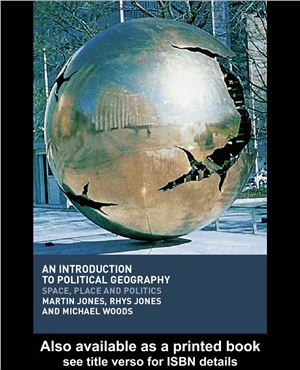Routledge, 2004. 202 p.
Questions of the interaction between politics and geography permeate much of contemporary life. In this broad-based introduction to contemporary political geography, the authors examine the relationship between politics and geography at a variety of levels and in a number of different contexts. By pushing back the boundaries of what is conventionally understood to constitute political geography, the book emphasises the relationships between power, politics and policy, space, place and territory in different geographical contexts.
An Introduction to Political Geography explores how power interacts with space, how place influences political identities and how policy creates and remoulds territory. In outlining the full breadth of contemporary political geography, covering a rich and diverse range of topics, it addresses not only traditional conces such as state formation, geopolitics, electoral geography and nationalism but also newer themes, including the geographies of regulation and goveance, public policy, the politics of place consumption, landscapes of power, identity politics and geographies of resistance.
This accessible text successfully combines discussion of cutting-edge conceptual debates with inteational case studies, numerous illustrations and explanatory boxes. An Introduction to Political Geography will be essential reading for political geographers as well as a valuable resource for students of related fields with an interest in politics and geography.
Power, space and ‘political geography’.
State, territory and regulation.
States and territories.
The state in global perspective.
The state’s changing forms and functions.
Politics, power and place.
The political geographies of the nation.
Politics, power and place.
Contesting place.
People, policy and geography.
Democracy, participation and citizenship.
Public policy and political geography.
Postscript.
Questions of the interaction between politics and geography permeate much of contemporary life. In this broad-based introduction to contemporary political geography, the authors examine the relationship between politics and geography at a variety of levels and in a number of different contexts. By pushing back the boundaries of what is conventionally understood to constitute political geography, the book emphasises the relationships between power, politics and policy, space, place and territory in different geographical contexts.
An Introduction to Political Geography explores how power interacts with space, how place influences political identities and how policy creates and remoulds territory. In outlining the full breadth of contemporary political geography, covering a rich and diverse range of topics, it addresses not only traditional conces such as state formation, geopolitics, electoral geography and nationalism but also newer themes, including the geographies of regulation and goveance, public policy, the politics of place consumption, landscapes of power, identity politics and geographies of resistance.
This accessible text successfully combines discussion of cutting-edge conceptual debates with inteational case studies, numerous illustrations and explanatory boxes. An Introduction to Political Geography will be essential reading for political geographers as well as a valuable resource for students of related fields with an interest in politics and geography.
Power, space and ‘political geography’.
State, territory and regulation.
States and territories.
The state in global perspective.
The state’s changing forms and functions.
Politics, power and place.
The political geographies of the nation.
Politics, power and place.
Contesting place.
People, policy and geography.
Democracy, participation and citizenship.
Public policy and political geography.
Postscript.

